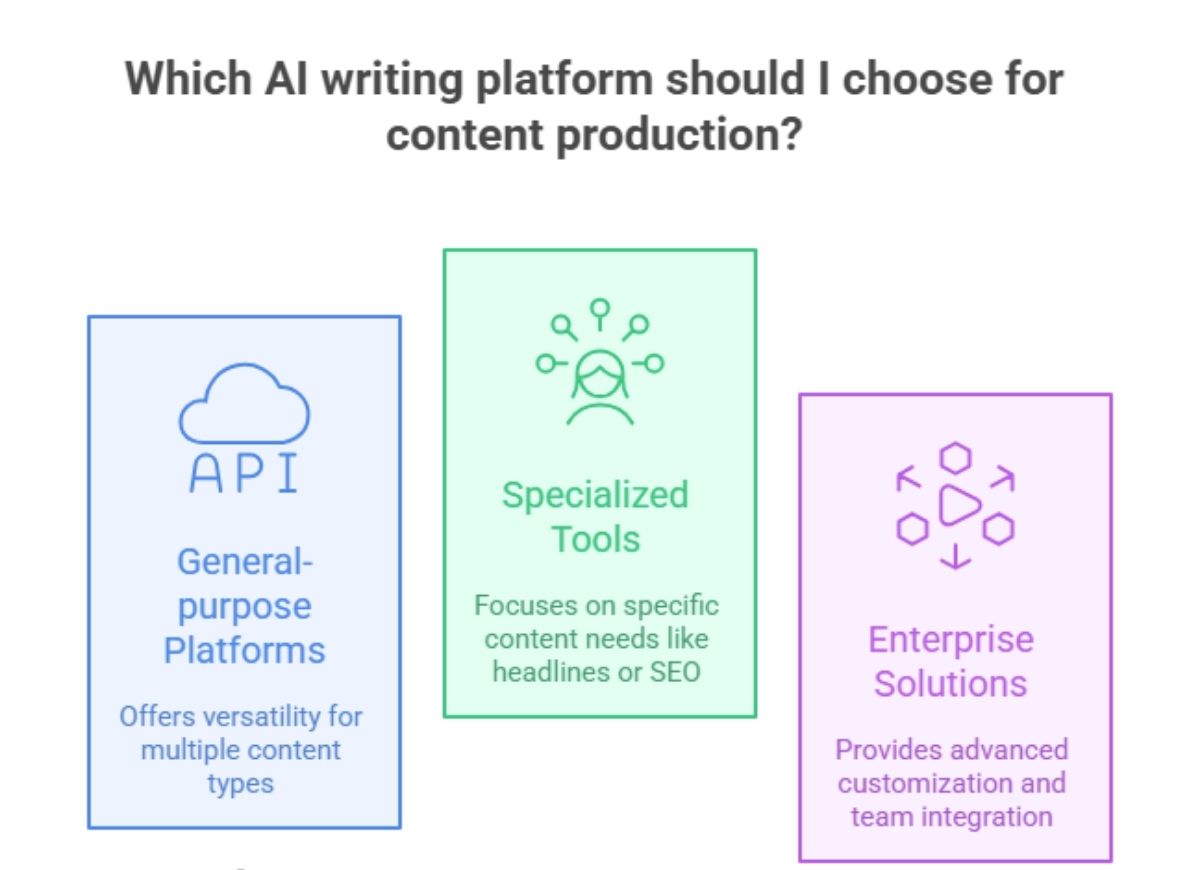Let’s face it. Content creation is a monster that’s always hungry. Blogs, social posts, emails, videos. Businesses need more content than ever, but who has the time? That’s where AI steps in. You can automate content creation with AI while keeping your unique brand voice intact. It’s not science fiction anymore. It’s happening right now in marketing departments worldwide.
“AI won’t replace marketers, but marketers who use AI will replace those who don’t.”
— Paul Roetzer, Founder & CEO, Marketing AI Institute
Just throwing AI at your content won’t cut it. You need a strategy, the right tools, and knowledge of how to guide these systems to speak in your brand’s voice. Ready to multiply your content output without sacrificing quality? Let’s dive in.
Set Up AI for Content Production
Getting started with AI content creation means building a system that works for your specific needs:
Pick the right AI writing platform
Not all AI writing tools are created equal. Your choice should match your primary content needs.
-
General-purpose platforms: Jasper, Copy.ai, and ChatGPT offer versatility for multiple content types
-
Specialized tools: Headlime for headlines, Quillbot for paraphrasing, or Surfer SEO for search-optimized content
-
Enterprise solutions: Persado or Writer for advanced customization and team integration
According to the Content Marketing Institute’s 2024 B2B Report, 70% of marketers are already using generative AI tools for content creation and strategy.
This shows AI in marketing is no longer experimental; it’s a competitive necessity.
Connect tools with your CMS or planner
The magic happens when your AI tools talk to your existing systems. Look for platforms with WordPress plugins, Zapier integrations, or API access to create workflows where:
-
Content briefs in Notion trigger AI draft creation
-
AI-generated drafts automatically land in WordPress as drafts
-
Completed content gets scheduled through your calendar tool
Use NLG tools to write first drafts
Natural language generation tools shine at creating structured content from basic prompts. Start with clear instructions that include topic focus, audience details, tone, key points, and structure preferences.
Create template prompts for recurring content types to standardize your approach and help AI tools learn what you want over time.
Customize AI Output to Match Brand Voice
The biggest concern with AI content? It can sound generic if you don’t customize it.
A Writer.com 2024 survey found that brands training AI on internal tone guides saw 43% higher engagement compared to those using generic AI outputs.
Here’s how to make AI write like a team member who understands your brand:
Train AI with brand voice samples
AI learns by example. Give it plenty of your best content:
-
Collect 5-10 pieces that perfectly capture your brand voice
-
Include different formats if that’s what you’ll be creating
-
Create a “voice guide” with explicit examples of preferred phrasing
Many AI platforms let you upload these samples directly or create custom “tones” based on them.
Set writing tone and style settings
Use the tone and style controls available in most AI writing tools:
|
Voice Element |
How to Adjust |
|---|---|
|
Formality |
Set from casual to formal based on your brand |
|
Sentence Length |
Configure for short and punchy or longer, detailed sentences |
|
Industry Terms |
Create custom dictionaries of preferred terminology |
|
Humor Level |
Adjust from strictly professional to conversational |
Create different voice presets for various content types if needed.
Review samples for consistency
Implement a regular review process:
-
Generate sample content using your AI setup
-
Have brand guardians review for voice consistency
-
Note where the AI output doesn’t match expectations
-
Refine your prompts based on these insights
-
Repeat monthly to continuously improve alignment
This feedback loop is crucial. The more you guide the AI, the better it gets at capturing your unique voice.
Use AI Across Formats Beyond Blogs
AI can power your entire content ecosystem when used strategically:
Create blog posts with AI in bulk
Scale your blog production with these steps:
-
Start with topic clusters (5-7 related topics)
-
Create a standard blog brief template
-
Generate first drafts for all topics in one session
-
Edit in batches for efficiency
Hootsuite’s 2024 Benchmark Report revealed that marketers using AI for content repurposing reduced production time by 58% on average.
By automating transformation instead of creation from scratch, teams free up time for creative strategy and personalization.
Turn AI text into social content
Use AI to extract and transform blog content into social posts:
-
Extract 5-10 key quotes from each blog post
-
Generate platform-specific variations (Twitter, LinkedIn, Instagram)
-
Create conversation starters based on blog content
-
Develop visual content prompts for designers
This “content atomization” stretches one piece into dozens of assets.
Repurpose long-form into emails or scripts
AI excels at format shifting. Transform existing content with simple prompts:
-
Convert blog posts into email sequences
-
Transform how-to articles into video scripts
-
Turn case studies into presentation outlines
-
Reshape webinar content into downloadable guides
This ensures content consistency across channels while saving creation time.
Build a Scalable, AI-Driven Workflow Without Losing Control
Automating content creation with AI isn’t about replacing human creativity. It’s about amplifying it. By implementing the right tools, customizing outputs to match your brand voice, and applying AI across multiple formats, you’re creating opportunities for more strategic work.
Start small with one content type. Perfect your process. Then expand. Before long, you’ll have a content engine that produces more than you thought possible, all while maintaining the authentic voice that makes your brand special.
Remember that AI is your assistant, not your replacement. The most successful AI content strategies still have humans directing strategy, providing feedback, and adding those creative touches that technology can’t quite replicate. Yet.
FAQs
Can AI preserve a unique brand voice in blogs?
Yes, AI can maintain your brand voice when properly trained. The key is providing examples of your existing content, creating clear style guidelines, and consistently reviewing outputs to refine the approach. Most advanced platforms allow you to create custom voice profiles that reflect your brand’s characteristics. The more you train and guide the system, the better it becomes at capturing your distinctive voice.
How do I use artificial intelligence in content creation at scale?
Scaling requires systematizing your approach. Create detailed templates for different content types, generate first drafts in bulk, and implement a consistent editing workflow. Connect your AI tools directly to your CMS through integrations. With the right setup, one person can manage content that would typically require several full-time writers.
What are the core benefits of AI in writing blog content?
The primary benefits include increased production speed, consistent publishing schedules, reduced content costs, and broader topic coverage. AI also creates structured content that follows SEO best practices. Most importantly, using AI for first drafts frees human talent to focus on strategy and adding personal touches that truly connect with audiences.
Are natural language generation tools good for SEO?
When used properly, yes. Many AI writing platforms include built-in SEO features for keyword placement, readability, and content structure. They’re good at creating comprehensive content that covers related subtopics. Human oversight remains essential for verifying accuracy and adding unique insights that search engines value.
How can startups use AI for content marketing without experts?
Startups can leverage user-friendly platforms like Jasper or Copy.ai that require minimal training. Focus on creating detailed prompts that include your audience, goals, and preferred style. Use built-in templates for common content formats. Have at least one team member learn effective prompt engineering. Start with high-volume needs like social media or product descriptions, then gradually expand to more complex content types.

Ridam Khare is an SEO strategist with 7+ years of experience specializing in AI-driven content creation. He helps businesses scale high-quality blogs that rank, engage, and convert.




